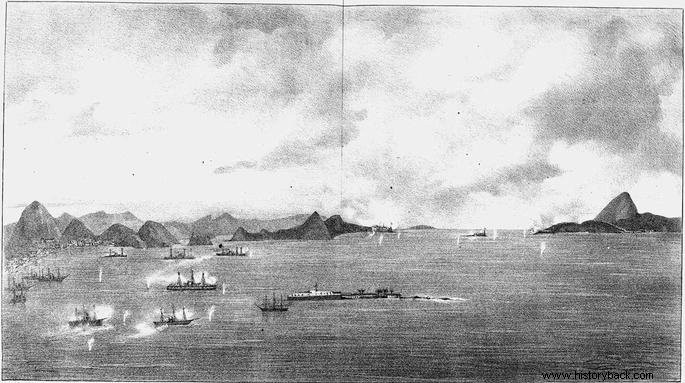The Armed Revolt (1891-1894), which took place in Rio de Janeiro, was a rebellion carried out by the Navy, which at the time was called “Armada” and hence the name of this movement.
The rebellion begins with the closing of Congress by President Deodoro da Fonseca, on November 3, 1891, and ends with the government of Floriano Peixoto, in April, 1894.
Therefore, the conflict is divided into two:First Revolt of the Armada, under the government of Deodoro da Fonseca, and Second Revolt of the Armada, under the presidency of Floriano Peixoto.
Objectives of the Armada Revolt
The main objective of the First Armada Revolt was to force President Deodoro da Fonseca to reopen Congress and end the state of siege.
They also wanted to equalize the rights and salaries of the Army and Navy and increase the role of this weapon in the government.
The Second Armada Revolt fought against the violent repression of Floriano Peixoto during the Federalist Revolution that took place in the south of the country at the same time. The leaders of both uprisings contacted and sought to unite.
Causes of the Armada Revolt
The Navy was dissatisfied with the direction the republic was taking. After all, the first two governments were exercised by two representatives of the Army:Deodoro da Fonseca and Floriano Peixoto. It is not by chance that this period is known as the “Republic of the Sword” (1889-1894).
Traditionally, the Navy was a weapon linked to the monarchy and had neither participated nor supported the coup of the Republic on November 15, 1889. Therefore, they were anxious for Floriano to leave and for Admiral Custódio de Melo (1840-1902) to enter. intended to run for president.
Thus, the revolt is declared and led by Saldanha da Gama and Custódio de Melo, among other Navy officers.
First Revolt of the Armada (1891)
The First Armada Revolt took place in response to the closure of Congress and the state of siege by President Deodoro da Fonseca. Such attitudes were against the Constitution of 1891.
Led by Admiral Custódio de Melo, Minister of the Navy, the uprising began in 1891. The warships anchored in Rio were taken by the rebels and began to patrol Guanabara Bay, dropping bombs on the then capital of the Republic.
The fortresses that defended Guanabara Bay, however, remained loyal to the government and fighting was intense.
As a result, the insurgents succeeded in the resignation of President Deodoro da Fonseca, on November 23, 1891.
Second Armada Revolt (1892-1894)
The second Armada Revolt arises from the dissatisfaction of the oligarchic class against the government of Floriano Peixoto.
The constitutional text stated that if the president had not served two years in office, new elections should be called. However, Deodoro had only been in the presidency for nine months and a new election should be held.
Therefore, thirteen generals signed a manifesto demanding that Floriano Peixoto call new elections. The president's response was to arrest these officers.
Likewise, the Navy articulated itself by apprehending the warships in Guanabara Bay. The main leaders were Admirals Luís Filipe de Saldanha da Gama and Custódio José de Melo, who attacked Rio de Janeiro and the city of Niterói. Repressed by the army, some rebels joined the Federalist Revolution that was taking place in the south of the country.
Faced with the bombings, the population abandoned Rio de Janeiro and the country's capital was temporarily transferred to the city of Petrópolis.

Federalist Revolution and Armada Revolt
While the Armada Revolt took place in Rio de Janeiro, the south of the country was undergoing the Federalist Revolution (1893-1895). Also called the Federalist Revolt was a civil war that took place in the state of Rio Grande do Sul and spread to Santa Catarina and Paraná.
This movement was characterized by the dispute between the Federalists (maragatos) and the republican army (pica-paus). It was actually a conflict between two models of republic:decentralized (federalist) and centralized (positivist).
In 1894, Admiral Custódio de Melo leads the ship "Aquidabã" towards the south to support the Federalists against Floriano Peixoto. However, the vessel is torpedoed on the island of Desterro (SC), marking the end of the conflict.
In fact, in Santa Catarina, on the island of Desterro, there were the bloodiest episodes of repression with arbitrary arrests and summary shootings. The city changed its name when the conflict ended and changed its name to Florianópolis.
Learn more:Federalist Revolution
End of the Armada Revolt
Floriano Peixoto's repression of the insurgents was relentless and, for this reason, he received the nickname "Iron Marshal".
The victory, however, cost the government dearly, which spent all available reserves buying, in Europe and the United States, ships to fight the rebels. American officers and sailors also participated in the military maneuvers, raising criticism in the press.
As for the leaders of the Armada Revolt, Custódio de Melo left for Buenos Aires and only returned to Brazil after the amnesty. For his part, Saldanha da Gama died in combat, in 1895, in Campo de Osório (RS).
We have more texts on the subject for you :
- Deodoro da Fonseca
- Floriano Peixoto
- Republic of the Sword
